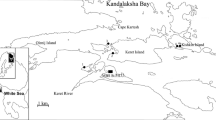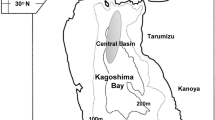Abstract
Growth rates in the infaunal nuculanid bivalve mollusc Yoldia eightsi (Couthouy) were assessed for field populations in Factory Cove, Signy Island, Antarctica, between. February and April 1992. Daily increments in length (maximum shell dimension) ranged from 2.3 μm d-1 for a 30 mm individual to 5.1 μm d-1 for a 10 mm specimen. These growth rates were converted to annual increments, based on a growing season for the Signy population of around 5 mo, and ages for the largest individuals in the population (35 mm in length), were calculated to be ≃65 yr. Specimens of 43 mm in length have been found near this site and, if their growth rates are similar to this population, their ages would be in the order of 120 yr. Size distributions from two sites in the same Y. eightsi bed 300 m apart showed significant differences. At the more exposed site the distribution was dominated by small juveniles, with 86% of the population 10 mm in length, while 13% were >20 mm in length. At the less exposed site the values were 27% <10 mm and 56% >20 mm. Icebergs have often been seen grounded on the Y. eightsi bed in this study, especially on the exposed outer portion. This factor, in association with inhibition of larval settlement by high densities of large individuals, is proposed as an explanation of the observed population distributions and the absence of very large specimens in the Factory Cove population.
Similar content being viewed by others
Literature cited
Barnes, P. W., Rearic, D. M., Reimnitz, E. (1984). Ice gouging characteristics and processes. Academic Press, New York
Barry, J. P., Dayton, P. K. (1988). Current patterns in McMurdo Sound, Antarctica and their relationship to biological production of local benthic communities. Polar Biol. 8: 367–376
Bond, G., Heinrich, H., Broecker, W., Labeyrie, L., McManus, J., Andrews, J., Huon, S., Jantschik, R., Clasen, S., Simet, C., Tedesco, K., Klas, M., Bonani, G., Ivy, S. (1992). Evidence for massive discharges of icebergs into the North Atlantic ocean during the last glacial period. Nature, Lond. 360: 245–249
Bryer, C. (1993). Growth lines of high latitude bivalves: implications for environmental monitoring. In: Proceedings of the British Antarctic Survey Antarctic Special Topic Award Scheme Symposium; Heywood, R. B. (ed.) British Antarctic Survey, Cambridge, England (in press)
Crowe, W. A., Josefson, A. B., Svane, A. (1987). Influence of adult density on recruitment into soft sediments: a short-term in situ sublittoral experiment. Mar. Ecol. Prog. Ser. 41: 61–69
Davenport, J. (1988). The feeding mechanism of Yoldia (=Aequiyoldia) eightsi (Couthouy). Proc. R. Soc. (Ser. B) 282: 431–442
Davenport, J. (1989). Feeding, oxygen uptake, ventilation rate and shell growth in the Antarctic protobranch bivalve mollusc Yoldia eightsi (Couthouy). In: Heywood, R. B. (ed.) Proceedings of the British Antarctic Survey Antarctic Special Topic Award Scheme Symposium. British Antarctic Survey, Cambridge, England, p. 57–63
Dayton, P. K. (1990). Polar benthos. In: Smith, W. O., Jr. (ed.) Polar oceanography. Part B. Chemistry, biology, and geology. Academic Press, San Diego, California, p. 631–685
Dayton, P. K., Robilliard, G. A., De Vries, A. L. (1969). Anchor ice formation in McMurdo Sound, Antarctica, and its biological effects. Science, N.Y. 163: 273–274
Dayton, P. K., Robilliard, G. A., Paine, R. T. (1970). Benthic faunal zonation as a result of anchor ice at McMurdo Sound, Antarctica. In: Holdgate, M. W. (ed.) Antarctic ecology. Academic Press, London, p. 244–258
Dayton, P. K., Watson, D., Palmisano, A. Barry, J. P., Oliver, J. S., Rivera, D. (1986). Distribution patterns of benthic standing stock at McMurdo Sound, Antarctica. Polar Biol. 6: 207–213
Delille, D. (1992). Marine bacterioplankton at the Weddell Sea ice edge, distribution of psychrophilic and psychrotrophic populations. Polar Biol. 12: 205–210
Delille, D., Bouvy, M., Cahet, G. (1988). Short term variations of bacterioplankton in Antarctic zone: Terre Adélie area. Microb. Ecol. 15: 293–309
Dell, R. K. (1964). Antarctic and sub-antarctic Mollusca: Amphineura, Scaphopoda and Bivalvia. Discovery' Rep. 33: 99–250
Dell, R. K. (1990). Antarctic Mollusca. Bull. R. Soc. N. Z. 27: 1–311
Elmgren, R., Ankar, S., Marteleur, B., Fjdung, G. (1986). Adult interference with post-larvae in soft sediments: the Pontoporeia-Macoma example. Ecology 62: 827–836
Gage, J. D. (1990). Skeletal growth markers in the deep-sea brittle stars Ophiura ljungmani and Ophiomusium lymani. Mar. Biol. 104: 427–435
Gage, J. D., Tyler, P. A. (1982). Growth and reproduction in the deep-sea brittlestar Ophiomusium lymani Wyville Thomson. Oceanol. Acta 5: 73–83
Gage, J. D., Tyler, P. A. (1991). Deep sea biology: a natural history of organisms at the deep sea floor. Cambridge University Press, Cambridge, UK
Gallagher, E. D., Jumars, P. A., Trueblood, D. D. (1983). Facilitation of soft bottom benthic succession by tube builders. Ecology 64: 1200–1216
Garrison, D. L., Sullivan, C. W., Ackley, S. F. (1986). Sea ice microbial communities in Antarctica. BioSci. 36: 243–250
Gilbert, N. S. (1991). Microphytobenthic seasonality in near-shore marine sediments at Signy Island, South Orkney Islands, Antarctica. Estuar., cstl Shelf Sci. 33: 89–104
Goodwin, C. R., Finley, J. C., Howard, L. M. (eds.) (1985). Ice scour bibliography. Arctic Science and Technology Information System, Environmental Studies Revolving Funds. Calgary, Alberta, Canada (Rep. No. 010)
Grossi, S. M., Kottmeier, S. T., Moe, R. L., Taylor, G. T., Sullivan, C. W. (1987). Sea ice microbial communites. VI. Growth and primary production in bottom ice under graded snow cover. Mar. Ecol. Prog. Ser. 35: 153–164
Gruzov, E. N. (1977). Seasonal alterations in coastal communites in the Davis Sea. In: Llano, G. A. (eds.) Proceedings of the 3rd S.C.A.R. Symposium on Antarctic Biology. Gulf Publishing Co., Houston, Texas, p. 263–279
Hedgpeth, J. W. (1971). Perspective of benthic ecology in Antarctica. In: Quam L. O. (ed.) Research in the Antarctic. American Association for the Advancement of Science, Washington, p. 93–136 (Publs Am. Ass. Advmt Sci. No. 93)
Heywood, R. B., Whitaker, T. M. (1984). The Antarctic marine flora. In: Laws, R. M. (ed.) Antarctic ecology. Vol. 2. Academic Press, London, p. 373–410
Hooper, R. G., Whittick, A. (1990). Seasonal seaweed community dynamics in a boreal/subarctic bay. Br. phycol. J. 25: p. 90
Keys, J. R. (1984). Antarctic marine environments and offshore oil. Commission for the Environment. Wellington, New Zealand
Legendre, L., Ackley, S. F., Diekmann, G. S., Gulliksen, B., Horner, R., Hoshiai, T., Melnikov, I. A., Reeburgh, W. S., Spindler, M., Sullivan, C. W. (1992). Ecology of sea ice biota. Polar Biol. 12: 429–444
Lien, R. (1983). Pløyemerker etter isfjell på norsk kontinentalsokkel. [Iceberg scouring on the Norwegian continental shelf]. Continental Shelf and Petroleum Technology Research Institute Ltd., Jarleslatta, Trondheim, Norway (Publ. No. 109)
Lien, R., Solheim, A., Elverhøi, A., Rokoengen, K. (1989). Iceberg scouring and seabed morphology on the eastern Weddell Sea shelf, Antarctica. Polar Res. 7: 43–57
Nicol, D. (1966). Descriptive ecology and geographic distribution of some Antarctic pelecypods. Bull. Am. Palaeontol. 51 (231) 1–102
Nolan, C. P., Clarke, A. (1993). Growth in the bivalve Yoldia eightsi at Signy Island, Antarctica, determined from internal shell increments and calcium-45 incorporation. Mar. Biol. 117: 243–250
Olafsson, E. B. (1989). Constrasting influences of suspension-feeding and deposit-feeding populations of Macoma balthica on infaunal recruitment. Mar. Ecol. Prog. Ser. 55: 171–179
Palmisano, A. C., Lizotte, M. P., Smith, G. A., Nichols, P. D., White, D. C., Sullivan, C. W. (1988). Changes in photosynthetic carbon assimilation in Antarctic sea-ice diatoms during spring bloom: variation in synthesis of lipid classes. J. exp. mar. Biol. Ecol. 116: 1–13
Peck, L. S., Culley, M. B. (1990). Structure and density of Haliotis tuberculata populations around the coasts of Jersey, Channel Isles. J. mar. biol. Ass. 70: 67–75
Petersen, C. H. (1982). The importance of predation and intra-and interspecific competition in the population biology of two infaunal suspension feeding bivalves, Protothaca staminea and Chione undatella. Ecol. Monogr. 52: 437–475
Rabarts, I. W. (1970). Physiological aspects of the ecology of two Antarctic lamellibranchs. British Antarctic Survey Base Report AD6/2H/1970/N9. British Antarctic Survey, Cambridge
Rabarts, I. W., Whybrow, S. (1979). A revision of the Antarctic and Subantarctic members of the genus Yoldia Möller, 1842 (Bivalvia: Nuculanidae). J. nat. Hist. 13: 161–183
Richardson, M. D., Hedgpeth, J. W. (1977). Antarctic soft-bottom macrobenthic community adaptations to a cold, stable, highly productive, glacially affected environment. In: Llano, G. A. (ed.) Adaptations within antarctic ecosystems. Gulf Publishing Co., Houston, Texas, p. 181–196
Sullivan, C. W., Palmisano, A. C. (1984). Sea ice microbial communites: distribution, abundance and diversity of ice bacteria in McMurdo Sound, Antarctica, in 1980. Appl. envirl Microbiol 47: 1348–1355
Woodin, S. A. (1974). Polychaete abundance patterns in a marine soft-sediment environment: the importance of biological interactions. Ecol. Monogr. 44: 171–187
Youge, C. M. (1939). The protobranchiate Mollusca: a functional interpretation of their structure and evolution. Phil. Trans. R. Soc. (Ser. B) 230: 79–147
Author information
Authors and Affiliations
Additional information
Communicated by J. Mauchline, Oban
Rights and permissions
About this article
Cite this article
Peck, L.S., Bullough, L.W. Growth and population structure in the infaunal bivalve Yoldia eightsi in relation to iceberg activity at Signy Island, Antarctica. Marine Biology 117, 235–241 (1993). https://doi.org/10.1007/BF00345668
Received:
Accepted:
Issue Date:
DOI: https://doi.org/10.1007/BF00345668




